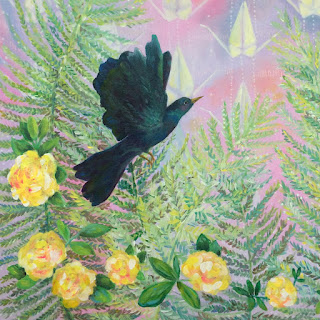Idea to Image: Near & Far
Near & Far, 24 x 30 x 1.5" (each) diptych, acrylic and ink on canvas. I created this two-panel painting specifically for the Faculty Art Exhibition at Northwest Vista College. I spent a good bit of time in my studio this past school year, mostly working on commissioned pet portraits and staring at the wall of paper cranes in between grading and updating course layouts.
The cranes have served as the backdrop for several works this year; I like the regularity of this pattern and the meaning behind it. My training as a printmaker comes through in the form of repetition. When I'm not editioning woodcuts, pattern finds its way into my work via subject matter and mark-making (the entire background is covered in delicate hatched lines & dots that don't show up on the photograph).
I started this piece by drawing in my sketchbook, making loads of semi-blind contours of birds and plants until I found the right combination. I cannot stress the importance of a sketchbook enough, especially for my own practice this year. Aside from the commissions, I found little time for my own paintings (at least the large scale ones I had planned). However, there was always time for my sketchbook. This kept me in touch with my ideas over the course of a very demanding semester.
There are several sketchbooks in rotation right now, my current favorite is a larger 14 x 17" that stays on my studio desk. I used the smaller one here so I could draw outside and enjoy the cool air over Spring Break.
There are several sketchbooks in rotation right now, my current favorite is a larger 14 x 17" that stays on my studio desk. I used the smaller one here so I could draw outside and enjoy the cool air over Spring Break.
Each canvas measures 2 feet by 2 1/2 feet. The background was blocked in first, then a rough layout of the subject matter with tracing paper. I do this to transfer my drawings from the sketchbook (typically I enlarge them using a grid). The tracing paper sketches also allow me to adjust the composition without commitment and quickly establish implied line, visual interest and balance. Pictured below are photos from each stage of the painting; the colors are a bit washed out, as I had to photograph at night. The final image shows the true color in natural light.
Stage 1: Background blocked in with a rough painting of the origami and ferns.
Stage 2: The main subjects transferred to tracing paper and laid out to establish placement. I had to consider movement across both canvases, so they would work together as a unit.
Stage 3: Birds are blocked in. Back to the sketchbook to figure out what else needs to happen. I chose to integrate some floating yellow roses from an earlier piece to frame in the bottom and provide another element of contrast with complementary colors
.
.
Finished & installed in the Palmetto Center for the Fine Arts at Northwest Vista College.












Comments
Post a Comment